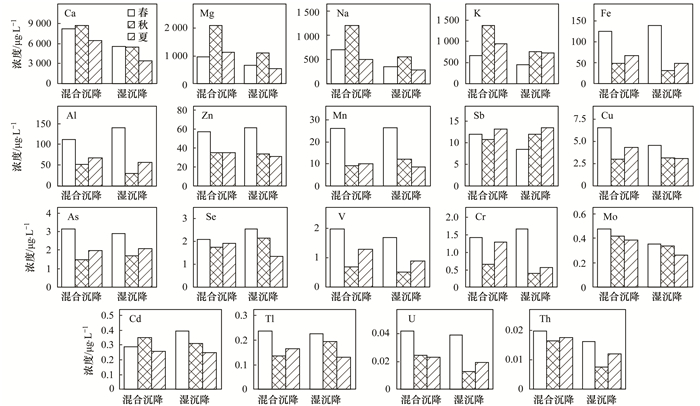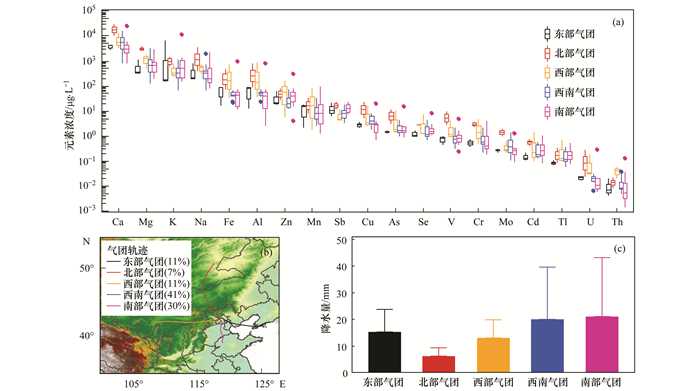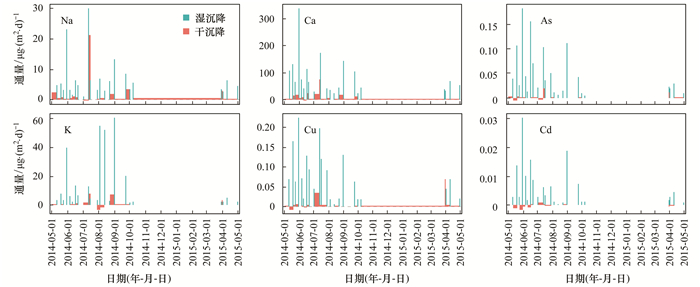2. 中国科学院大气物理研究所, 大气边界层物理和大气化学国家重点实验室, 北京 100029;
3. 东华理工大学测绘工程学院, 南昌 330013
2. State Key Laboratory of Atmospheric Boundary Layer Physics and Atmospheric Chemistry, Institute of Atmospheric Physics, Chinese Academy of Sciences, Beijing 100029, China;
3. Faculty of Geomatics, East China University of Technology, Nanchang 330013, China
与硫酸盐、硝酸盐、铵盐和有机物相比, 大气金属浓度较低, 但由于其危害较大, 是一类备受关注的污染物.大气中的金属元素多以颗粒态存在, 主要通过化石燃料燃烧、冶金工业排放、扬尘等途径进入大气环境[1], 经过在大气中的扩散传输最终以干湿沉降的方式返回地表[2], 进而对排放源周围的生态系统造成持久性影响[3].以往研究认为, 湿沉降是大气中金属的主要清除途径, 国内外的研究也多以湿沉降为主[4].然而, 近年来也有研究认为干沉降在大气金属的清除过程中占主导地位[5].关于“大气中金属的沉降过程是以干沉降为主还是湿沉降为主”存在一定的争议, 而这种争议不仅与研究区域和污染状况有关[6], 还与不同的观测方法有关[7].
大气金属沉降的观测方法主要是湿沉降和混合沉降两种方法.混合沉降采样方法是将采样容器完全暴露在大气中被动收集降水.湿沉降采样方法需要依靠传感器响应降水事件, 只在降水事件发生时采集降水.相比之下, 大气金属干沉降采样方法相对缺乏, 以往主要以固体[8]或液体[9]代用面为主.固体代用面(干法采样)主要采用玻璃、陶瓷等材质; 液体代用面(湿法采样)主要采用水、乙二醇等.然而, 代用面也存在一定的局限性.比如, 黏性介质的代用面往往造成干沉降的高估, 而光滑介质的代用面会低估干沉降通量[10].
为避免代用面法的局限性, 探寻一种简便合理的干沉降观测方法尤为重要.由于被动采样获得的混合沉降样品包含了颗粒物和雨水中的金属, 因而可以表征金属的大气沉降总量.而主动采样获得的雨水样品表征的是湿沉降, 通过混合沉降和湿沉降这两种采样方法差减即可间接估算大气中金属以颗粒物相态发生的干沉降通量.这种间接法曾被应用于湖泊、近海和森林下垫面水溶性无机盐干沉降通量的估算[11, 12], 但很少用于城市地区大气金属干沉降通量的估算研究.
京津冀大气重金属污染比较严重[13], 干湿沉降量较大[14].作为京津冀典型的大城市, 北京大气重金属湿沉降研究较多, 干沉降的报道较少, 且因观测方法不同导致结论各异[14, 15].本文采用主动采样和被动采样两种方法同步收集大气沉降样品(同步观测法), 研究北京城区大气中金属的干湿沉降特征, 结果有助于认知大气中金属元素的清除过程, 评估大气重金属沉降的生态环境效应.
1 材料与方法 1.1 采样方法采样点位于中国科学院大气物理研究所铁塔分部(39°58′N, 116°22′E), 站点周围无局地污染源.被动采样器(不锈钢, 直径20 cm, 高1.5 m)和主动采样器(APS-2B型, 模压聚乙烯, 直径30 cm, 高1.4 m, 长沙湘蓝科学仪器有限公司)均置于办公楼楼顶(楼高约6 m).采样严格按照中国气象局颁布的地面气象观测规范进行.采样时用量筒准确量取降水体积, 每种采样法收集的样品各用2个50 mL的PET小瓶冷冻保存, 一个月内完成分析.每次样品采集后, 用去离子水(电阻率18.2 MΩ·cm)冲洗采样设备, 以防止残留对下次样品产生影响.在2014年5月~2015年4月观测期内共收集混合沉降33个, 湿沉降29个.降水量小于1 mm时, 自动采样器的降水感应器有时不能感应到降水, 导致两种采样方式的样品数量不相等.
1.2 分析方法 1.2.1 样品前处理取解冻后的样品20mL并用硝酸(Sigma-aldrich, 德国)调节pH值约等于1, 静置24 h后取其上清液待测.
1.2.2 样品分析采用电感耦合等离子体质谱仪(ICP-MS 7500ce, Agilent)分析样品中的Be(铍)、Na(钠)、Mg(镁)、Al(铝)、K(钾)、Ca(钙)、V(钒)、Cr(铬)、Mn(锰)、Fe(铁)、Co(钴)、Ni(镍)、Cu(铜)、Zn(锌)、As(砷)、Se(硒)、Mo(钼)、Cd(镉)、Sb(锑)、Ba(钡)、Tl(铊)、Pb(铅)、Th(钍)、U(铀)和Ag(银)等25种金属.每个样品测试3次, 根据内标元素[45Sc(钪)、72Ge(锗)、115In(铟)和209Bi(铋)、Part #5188-6525, Agilent]相对标准偏差(RSD)来控制仪器测试的稳定性, 要求内标元素RSD < 3%, 否则重新测试样品.测试过程中每10个样品为一组.每组样品测试结束后, 测试一次标准样品, 若元素RSD>5%, 则对仪器进行重新调谐、标定并重测本组样品.实验分析过程质量控制和质量保障技术方法参考文献[14]. Be、Co、Ni、Ba、Pb和Ag这6种金属没有通过数据质量控制, 所以本文只讨论19种金属的沉降规律.
1.2.3 干沉降通量的估算方法同步观测法估算大气金属干沉降量的原理是:干沉降量等于总沉降量减去湿沉降量[16].绝大部分金属无气态干沉降[17], 多以颗粒物的相态直接沉降或被雨水清除, 所以混合沉降采样法表征的是大气金属沉降总量; 主动采样器只在降水事件发生时采集样品, 其余时间处于关闭状态, 因而排除了干沉降的影响, 表征的是湿沉降量.混合沉降通量减去湿沉降通量在理论上等于两次降水事件之间的干沉降量.干沉降的估算公式如下:

|
(1) |
式中, df(i)为金属i在相邻两次降雨事件之间干沉降量, tf(i)和wf(i)分别表示金属i混合沉降量及湿沉降量, mg·m-2.
假定在两次降水之间污染物以干沉降的方式被均匀清除, 则每日的金属干沉降量计算公式如下:

|
(2) |
式中, Df(i)为金属i在相邻两次降水过程之间日均干沉降通量, mg·(m2·d)-1, t为相邻两次降水过程间隔时间, d.分别累加全年降水df(i)、tf(i)和wf(i)得到金属i年干沉降通量、年总沉降通量和年湿沉降通量; mg·(m2·a)-1.
2 结果与讨论 2.1 混合沉降和湿沉降中金属元素的浓度水平及富集特征图 1为混合沉降和湿沉降样品浓度统计.可以看出, 两种样品中金属浓度大小次序一致: Ca浓度最高, 其次是Mg、K、Na、Fe和Al, 而Zn、Cu、As、Cr和Cd等重金属浓度较低(表 1).然而, 混合沉降各金属浓度普遍高于湿沉降.这是因为混合沉降样品中金属浓度水平不但受湿沉降影响, 也受干沉降的影响.另外, 混合沉降样品金属浓度的离群值比湿沉降多.通过对逐次降水样品分析, 发现当降水间隔天数增多的时候, 干沉降量相应增大; 并且降水量较小时, 降水对金属浓度的稀释作用减弱[5]; 两者共同导致混合沉降样品的金属浓度显著高于同期采集的湿沉降样品.

|
箱体表示正常范围(上限、上四分位数、中位数、下四分位数以及下限); 点表示离群值(大于上四分位数1.5倍的四分位距或小于下四分数-1.5倍的四分位距) 图 1 不同采样方式大气沉降样品金属浓度 Fig. 1 Concentration of trace elements in precipitation by different sampling methods |
|
|
表 1 不同采样方式沉降样品金属浓度统计量/μg·L-1 Table 1 Statistics for precipitation trace elemental concentrations in bulk and wet depositions/μg·L-1 |
为了解沉降样品中各金属的污染水平, 以Al为参比, 计算各金属的富集因子(EF)[18], 计算公式为:

|
(3) |
式中, EF(i)为金属i的富集因子, (ci/cAl)precipitation为沉降样品中金属i与Al的加权平均浓度之比, (ci/cAl)crust为地壳中金属i与Al浓度之比值.值得注意的是, 本研究对降水样品用硝酸酸化(pH≈1), 在一定程度是不能完全提取沉降样品中的金属元素, 会低估某些金属的浓度水平.但该方法对重金属的提取效果要优于矿物元素, 因而本研究用富集因子可以近似表征重金属元素的富集程度.
为排除背景值空间异质性的影响[19], 选择北京市各金属的土壤背景值进行EF估算.金属富集因子计算结果如图 2所示, 混合沉降和湿沉降同一金属EF在同一量级范围内, 其中Fe、Al、Th和U的EF < 10, 表明这4种金属富集不明显, 主要来自于地壳源; Cr、V、Mn、Na、K、Mg和Mo等金属EF值范围在10~100, 呈现中度富集; Cu、As、Ca、Tl、Zn、Cd、Se和Sb等金属的EF>100, 尤其是Cd、Se和Sb这3种金属的EF>1 000, 表明这些重金属已经严重富集, 主要来自人为污染源.

|
图 2 不同采样方式沉降样品金属富集因子 Fig. 2 Enrichment factors of trace elements in bulk and wet deposition |
混合沉降和湿沉降样品中各金属浓度的季节变化如图 3所示.由于本研究期间冬季无降水事件发生, 图 3只对比分析了春、夏和秋这3个季节的结果.除K、Na、Ca和Mg外, 其它金属都呈现出春季最高, 夏秋较低的季节变化趋势.春季高值可能是由于燃煤取暖和扬尘源排放的金属显著高于其它季节.夏秋季低值主要是由于北京地处温带季风气候, 夏季和秋季降水量较大, 稀释了各元素的浓度.

|
图 3 混合沉降和湿沉降样品金属浓度的季节变化 Fig. 3 Seasonal variation of elemental concentrations in bulk and wet deposition |
大气沉降样品金属浓度的高低不仅受降水量大小的影响, 在一定程度上还受到区域污染的影响.为进一步探明周边区域传输对大气沉降样品中金属浓度的影响, 通过TrajStat后向轨迹模型[20]聚类分析了不同类型气团控制下湿沉降样品的金属浓度特征(图 4).研究期间, 影响降水样品中金属浓度的气团为:北部气团>西部气团>西南气团或南部气团>东部气团.北部气团控制下湿沉降样品中绝大多数金属浓度比东部气团控制下高1个数量级, 这一差异与不同类型气团的降水量[图 4(c)]和气团所携带污染物量有关.

|
图 4 气团后向轨迹聚类及湿沉降金属浓度统计 Fig. 4 Precipitation and trace element concentraitons under different air mass trajectories |
从图 4可以看出, 西南气团和南部气团降水量相当, 降水中Mg、As、Fe和Mn的浓度也相当.但其它的金属在两个气团形成的降水中浓度差异很大.比如, 来自西南气团的降水中Ca、Al、Cu、Mo、U和Th浓度比南部气团高, 这可能是由于来自西部的气团携带了大量矿尘.而K、Na、Zn、Mn、Sb、Cd和Tl金属在南部气团形成的降水中浓度比西南气团高, 可能是由于南部气团途经山东西北部和河北东南部, 而这些地区是重金属排放较高的区域[21].
2.3 大气金属元素总沉降、干沉降和湿沉降特征对比图 5和图 6分别表示大气金属逐日及逐次沉降通量(根据金属元素在颗粒物不同粒径段的富集类型选取代表性元素Na、Ca、As、K、Cu和Cd).可以看出, 2015年3月31日绝大多数金属元素的干沉降在混合沉降样品中的占比为全年最大值, 这是因为2014年10月8日至2015年3月31日期间北京无有效降水, 降水间隔较长, 金属的干沉降量增多.地中海地区也观测到类似的现象[5].通过同步观测法估算的年尺度总沉降、湿沉降和干沉降通量分别为3 591.35 mg·(m2·a)-1(Ca)~0.01mg·(m2·a)-1(Th), 1 847.78 mg·(m2·a)-1(Ca)~0.01mg·(m2·a)-1(Th)和1 743.57 mg·(m2·a)-1(Ca)~0.01mg·(m2·a)-1(Th).值得注意的是, 在自然状态下的干沉降过程, 不仅与金属的粒径分布和浓度有关, 还会受到地表粗糙度和植被覆盖等下垫面性质的影响[10].因此, 本研究并不能完全量化自然状态下的干沉降, 可能会存在一定程度的低估.

|
图 5 大气金属逐日湿沉降和干沉降通量 Fig. 5 Dry and wet deposition fluxes of trace elements |

|
图 6 大气金属逐次混合和湿沉降量 Fig. 6 Bulk and wet deposition fluxes of trace elements of each sample |
表 2列出了国内外典型地区近30年重金属沉降通量观测结果.可以看出, 北京市Cd、Cu和V等金属的大气沉降量处于中等水平, 而Zn、As和Mn这3种金属沉降量明显较高.与国内其它地区相比, 北京大气中金属的沉降量偏低, 但处于同一范围.与以往北京的研究结果相比, 本研究各金属的沉降通量较小, 这可能与不同时间段的污染状况和采样方式有关[14, 15].
|
|
表 2 国内外大气金属沉降通量/mg·(m2·a)-1 Table 2 Atmospheric deposition fluxes of trace elements within and outside China/mg·(m2·a)-1 |
图 7为19种金属干湿沉降比例.其中Na、Mg、Th、Ca、Cr和Cu等金属干沉降通量占总沉降通量的比例均大于40%; Al、Mn、U、V、Fe、K和Mo这7种金属的干沉降占总沉降比例为23.9%~39.1%; Se、Zn、Tl、Sb、As和Cd等金属干沉降占总沉降比例小于20%.当某金属主要富集在粗粒径段(粒径>2.1 μm), 易通过重力作用发生沉降[27], 所以干沉降所占的比例较高, 如Ca和Mg等; 相反, 当某金属主要富集在细粒径段(< 2.1 μm), 颗粒物通过重力作用沉降的作用减弱, 而绝大多数重金属金属都富集在细颗粒物中, 主要以湿沉降的形式从大气中清除, 如As和Cd等; 当金属呈现双峰型或者多峰型粒径时, 干沉降占总沉降比例处于前面所述的粗粒径段富集和细粒径段富集的两种类型的金属之间, 如Al和Mn等[13].综上所述, 干/湿沉降对于大气金属的清除作用在一定程度上取决于金属富集在哪一个粒径段.

|
图 7 大气中金属元素的混合沉降和湿沉降通量 Fig. 7 Bulk and wet deposition fluxes of trace elements |
(1) 混合沉降样品各金属浓度普遍高于湿沉降样品.两种样品各金属富集因子差异较小, 除Fe、Al、Th和U等元素外, 其余金属都有不同程度的污染富集, 特别是As、Cd、Se和Sb等重金属呈现严重富集.
(2) 北京市夏秋季混合沉降样品和湿沉降样品中金属浓度较低, 而春季浓度较高; 不同降水气团控制下的湿沉降样品中金属的污染特征差异明显, 主要与气团所经过的区域有关(污染源区不同).
(3) 同步观测法估算北京大气金属干沉降量范围为1 743.57 mg·(m2·a)-1(Ca)~0.01mg·(m2·a)-1(Th).干/湿沉降对于大气金属的清除作用与颗粒物的粒径有关, 粒径越小的金属越容易以湿沉降方式被清除.
致谢: 感谢中国科学院大气物理研究所刘广仁老师在实验观测期间提供的帮助.| [1] | Lei Y, Zhang Q, He K B, et al. Primary anthropogenic aerosol emission trends for China, 1990-2005[J]. Atmospheric Chemistry and Physics, 2011, 11(3): 931-954. DOI:10.5194/acp-11-931-2011 |
| [2] | Zhu J X, Wang Q F, Yu H L, et al. Heavy metal deposition through rainfall in Chinese natural terrestrial ecosystems:evidences from national-scale network monitoring[J]. Chemosphere, 2016, 164: 128-133. DOI:10.1016/j.chemosphere.2016.08.105 |
| [3] | Al-Khashman O A, Jaradat A Q, Salameh E. Five-year monitoring study of chemical characteristics of Wet atmospheric precipitation in the southern region of Jordan[J]. Environmental Monitoring and Assessment, 2013, 185(7): 5715-5727. DOI:10.1007/s10661-012-2978-1 |
| [4] | Connan O, Maro D, Hébert D, et al. Wet and dry deposition of particles associated metals (Cd, Pb, Zn, Ni, Hg) in a rural wetland site, Marais Vernier, France[J]. Atmospheric Environment, 2013, 67: 394-403. DOI:10.1016/j.atmosenv.2012.11.029 |
| [5] | Muezzinoglu A, Cizmecioglu S C. Deposition of heavy metals in a Mediterranean climate area[J]. Atmospheric Research, 2006, 81(1): 1-16. |
| [6] | Grantz D A, Garner J H B, Johnson D W. Ecological effects of particulate matter[J]. Environment International, 2003, 29(2-3): 213-239. DOI:10.1016/S0160-4120(02)00181-2 |
| [7] | Breuning-Madsen H, Awadzi T W. Harmattan dust deposition and particle size in Ghana[J]. CATENA, 2005, 63(1): 23-38. DOI:10.1016/j.catena.2005.04.001 |
| [8] | Paode R D, Sofuoglu S C, Sivadechathep J, et al. Dry Deposition fluxes and mass size distributions of Pb, Cu, and Zn measured in Southern Lake michigan during AEOLOS[J]. Environmental Science & Technology, 1998, 32(11): 1629-1635. |
| [9] | Sakata M, Marumoto K. Dry deposition fluxes and deposition velocities of trace metals in the Tokyo metropolitan area measured with a water surface sampler[J]. Environmental Science & Technology, 2004, 38(7): 2190-2197. |
| [10] | Omrani M, Ruban V, Ruban G, et al. Assessment of atmospheric trace metal deposition in urban environments using direct and indirect measurement methodology and contributions from wet and dry depositions[J]. Atmospheric Environment, 2017, 168: 101-111. DOI:10.1016/j.atmosenv.2017.08.064 |
| [11] | Lee D S, Longhurst J W S. A comparison between wet and bulk deposition at an urban site in the U. K[J]. Water, Air, and Soil Pollution, 1992, 64(3-4): 635-648. DOI:10.1007/BF00483372 |
| [12] | Tsai Y I, Kuo S C, Young L H, et al. Atmospheric dry plus wet deposition and wet-only deposition of dicarboxylic acids and inorganic compounds in a coastal suburban environment[J]. Atmospheric Environment, 2014, 89: 696-706. DOI:10.1016/j.atmosenv.2014.03.013 |
| [13] | Tian S L, Pan Y P, Wang Y S. Size-resolved source apportionment of particulate matter in urban Beijing during haze and non-haze episodes[J]. Atmospheric Chemistry and Physics Discussions, 2015, 15(6): 9405-9443. DOI:10.5194/acpd-15-9405-2015 |
| [14] | Pan Y P, Wang Y S. Atmospheric wet and dry deposition of trace elements at 10 sites in Northern China[J]. Atmospheric Chemistry and Physics, 2015, 15(2): 951-972. DOI:10.5194/acp-15-951-2015 |
| [15] |
丛源, 陈岳龙, 杨忠芳, 等. 北京平原区元素的大气干湿沉降通量[J]. 地质通报, 2008, 27(2): 257-264. Cong Y, Chen Y L, Yang Z F, et al. Dry and wet atmospheric deposition fluxes of elements in the plain area of Beijing Municipality, China[J]. Geological Bulletin of China, 2008, 27(2): 257-264. DOI:10.3969/j.issn.1671-2552.2008.02.014 |
| [16] | Balestrini R, Arisci S, Brizzio M C, et al. Dry deposition of particles and canopy exchange:comparison of wet, bulk and throughfall deposition at five forest sites in Italy[J]. Atmospheric Environment, 2007, 41(4): 745-756. DOI:10.1016/j.atmosenv.2006.09.002 |
| [17] | Sparks J P, Walker J, Turnipseed A T, et al. Dry nitrogen deposition estimates over a forest experiencing free air CO2 enrichment[J]. Global Change Biology, 2008, 14(4): 768-781. |
| [18] | Duce R A, Hoffman G L, Zoller W H. Atmospheric trace metals at remote northern and southern hemisphere sites:pollution or natural?[J]. Science, 1975, 187(4171): 59-61. DOI:10.1126/science.187.4171.59 |
| [19] | Hernandez L, Probst A, Probst J L, et al. Heavy metal distribution in some French forest soils:evidence for atmospheric contamination[J]. Science of the Total Environment, 2003, 312(1-3): 195-219. DOI:10.1016/S0048-9697(03)00223-7 |
| [20] | Wang Y Q, Zhang X Y, Draxler R R. TrajStat:GIS-based software that uses various trajectory statistical analysis methods to identify potential sources from long-term air pollution measurement data[J]. Environmental Modelling & Software, 2009, 24(8): 938-939. |
| [21] | Tian H Z, Zhu C Y, Gao J J, et al. Quantitative assessment of atmospheric emissions of toxic heavy metals from anthropogenic sources in China:historical trend, spatial distribution, uncertainties, and control policies[J]. Atmospheric Chemistry and Physics, 2015, 15(17): 10127-10147. DOI:10.5194/acp-15-10127-2015 |
| [22] | Desboeufs K, Bon Nguyen E, Chevaillier S, et al. Fluxes and sources of nutrient and trace metal atmospheric deposition in the northwestern Mediterranean[J]. Atmospheric Chemistry and Physics, 2018, 18(19): 14477-14492. DOI:10.5194/acp-18-14477-2018 |
| [23] | Kyllönen K, Karlsson V, Ruoho-Airola T. Trace element deposition and trends during a ten year period in Finland[J]. Science of the Total Environment, 2009, 407(7): 2260-2269. DOI:10.1016/j.scitotenv.2008.11.045 |
| [24] | Theodosi C, Stavrakakis S, Koulaki F, et al. The significance of atmospheric inputs of major and trace metals to the Black Sea[J]. Journal of Marine Systems, 2013, 109-110: 94-102. DOI:10.1016/j.jmarsys.2012.02.016 |
| [25] | Wong C S C, Li X D, Zhang G, et al. Atmospheric deposition of heavy metals in the Pearl River Delta, China[J]. Atmospheric Environment, 2003, 37(6): 767-776. DOI:10.1016/S1352-2310(02)00929-9 |
| [26] | Wu Y C, Zhang J P, Ni Z X, et al. Atmospheric deposition of trace elements to Daya Bay, South China Sea:fluxes and sources[J]. Marine Pollution Bulletin, 2018, 127: 672-683. DOI:10.1016/j.marpolbul.2017.12.046 |
| [27] | Staelens J, De Schrijver A, van Avermaet P, et al. A comparison of bulk and wet-only deposition at two adjacent sites in Melle (Belgium)[J]. Atmospheric Environment, 2005, 39(1): 7-15. DOI:10.1016/j.atmosenv.2004.09.055 |
 2019, Vol. 40
2019, Vol. 40


